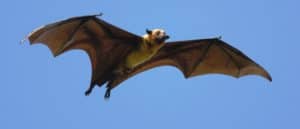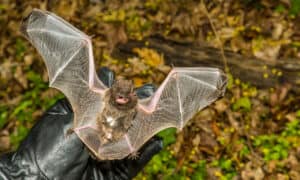Bats, like birds, must decide during freezing temperatures whether to stay or go. Bat movements are fueled by food availability, and warmer locations typically have an abundance of food during winter. So do bats migrate during the winter? Discover the answer below, including whether they hibernate and if bats can survive in freezing temperatures.
Do Bats Migrate?

Some bats migrate during the winter, while others choose to tough out the cold and hibernate.
©Sarun T/Shutterstock.com
Yes, some bat species migrate during the winter. Others may choose to tough out the colder months, and some even hibernate. Many creatures simply cannot cope with the lack of resources during winter, specifically food. However, not much research has been conducted on bat migration. But we know that migration depends heavily on the roost location and its proximity to warmer weather. The little brown bat has populations that migrate for winter and some that stay in their environments and sleep through it.
Why Do Bats Migrate?

Bats migrate to find food, often traveling to warmer locations, like Mexico, to find fruiting plants.
©Rudmer Zwerver/Shutterstock.com
Bats typically migrate to find food. Winters in northern regions don’t provide flowering or fruiting plants, which means there are no insects, fruits, or seeds available. Many bat species will die without access to food and, therefore, must migrate to areas warm enough to produce a food supply year-round. Bats also use a significant amount of energy from flying and must consume large quantities to fuel their daily activities, forcing them to choose between migration and hibernation.
When and Where Do Bats Migrate?
Where and when bats migrate largely depends on their species and location. A good example of migration is the hoary bat. This species spends springs and summers in northern regions of the United States and migrates to the US coasts and Northern Mexico during fall. The Mexican free-tailed bat moves short distances in the United States. It spends summers in central areas, like Kansas and Oklahoma, and migrates to the Southwest and Mexico during the cold months. Bats move back to their preferred habitats during spring in time for the summer.
How Far Do Bats Migrate?
Bats, unlike birds, do not typically migrate long distances. They are more likely to move short distances, just far enough for them to find a suitable food supply. It is also unusual to see bats migrating to different continents. Most species do not travel more than 1,200 miles from their preferred environments. In fact, most bats only move around 100 miles away on average.
Do Bats Hibernate?

Bats may travel up to 100 miles to find hibernation spots, where they decrease their heart rates and body temperatures for the winter.
©Ondrej Prosicky/Shutterstock.com
Many bats simply can’t expend the energy needed to migrate long distances, so they choose to hibernate. The most they are willing to travel to find a hibernation spot is no more than a couple of hundred miles. In late summer, hibernating species begin storing fat reserves to last the long winter. During hibernation, they only briefly stir to drink and urinate. And unlike bears, bats are true hibernators, drastically decreasing their heart rate and body temperature.
Where Do Bats Hibernate?
Bats require stable temperatures during migration, ranging from 32 and 49 degrees Fahrenheit. They prefer dark and secluded areas, such as caves, rock crevices, mines, attics, and other well-hidden structures. They begin hibernation between October and November and emerge from their deep-sleep state in March. Bats typically hibernate in colonies, but you can also find them alone during the winter.
Can Bats Live in Freezing Temperatures?

Bats can’t handle freezing temperatures and will freeze in temperatures below 32 degrees.
©Hermann Moller/Shutterstock.com
Bats can not handle freezing temperatures; they can freeze to death in temperatures below 32 degrees. Even for species that stay in their environments during winter, they will find a suitable place, like inside insulation in homes to keep warm. They may enter a state called “torpor” that allows them to save energy for several hours or up to one month.
Do Bats Come Back to the Same Place Every Night?
When bats return from their wintering habitats, they typically return to the same roosting spot. They will also use the same place every day, feeding at night and returning later to sleep. Homeowners who have a bat problem find they are difficult to get rid of as they always return to their preferred roosting area.
The photo featured at the top of this post is © Photoongraphy/Shutterstock.com
Thank you for reading! Have some feedback for us? Contact the AZ Animals editorial team.






